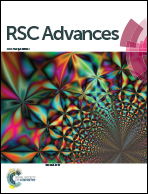Self-expansion, self-exfoliation and self-dispersion: insights into colloidal formation of atomically thin two-dimensional MoO2.5(OH)0.5†
Abstract
Large-scale synthesis of colloidal two-dimensional (2D) monolayered nanosheets has been a great challenge for material science. The difficulties are caused by the low exfoliation ability of 2D bulk materials, the poor dispersion and high instability of colloidal solutions. Conventional exfoliation and dispersion of these bulk 2D materials usually involve chemical modification via functionalization, intercalation or oxidation, which was detrimental to their intrinsic physical and chemical properties. In the present study, we develope a novel “green” liquid exfoliation method to prepare highly dispersible colloidal MoO2.5(OH)0.5 nanosheets in water. The as-obtained water-dispersible colloidal solutions (average particle size 20 nm and thickness 0.6–0.8 nm) kept in stable state longer than 10 months and show time-dependent photoluminescence (PL). Based on the results of combined time-dependent ex situ TEM observation experiments and ex situ XRD simulations, a novel “self-expansion and self-exfoliation” model was proposed to elucidate the formation of colloidal formation of atomically thin 2D MoO2.5(OH)0.5. It is expected that the present method has potential to be extended to colloidal formation of other layered compounds.


 Please wait while we load your content...
Please wait while we load your content...